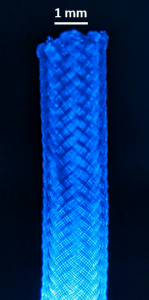Peripheral Nerve Regeneration and Treatment
Next Generation Nerve Guidance Conduit Development
 Current synthetic nerve guidance conduits (NGCs) are comprised of materials that are at best bio-inert, and may produce acidic byproducts upon degradation. Accordingly, clinical use of these products has been limited to the repair of short sensory nerve defects. The Kohn lab has combined polymer chemistry, materials science, and biomedical engineering expertise to develop and manufacture porous and flexible NGCs from a novel class of polymers capable of eliciting regenerative responses from injured nerve tissue. When implanted in rodents, the conduits effectively facilitate regeneration across nerve gaps, demonstrating promising potential for the repair of human peripheral nerves.
Current synthetic nerve guidance conduits (NGCs) are comprised of materials that are at best bio-inert, and may produce acidic byproducts upon degradation. Accordingly, clinical use of these products has been limited to the repair of short sensory nerve defects. The Kohn lab has combined polymer chemistry, materials science, and biomedical engineering expertise to develop and manufacture porous and flexible NGCs from a novel class of polymers capable of eliciting regenerative responses from injured nerve tissue. When implanted in rodents, the conduits effectively facilitate regeneration across nerve gaps, demonstrating promising potential for the repair of human peripheral nerves.
Fusogens
Traumatic peripheral nerve injuries affect over half a million people every year, causing billions of dollars in disability. Even a year after surgical repair only 50% of patients can expect improvement, many continue to have chronic pain, persistent weakness and numbness for the rest of their lives. Despite this the current standard of care treatment hasn’t changed in over 30 years. At the Kohn lab we are exploring a class of molecules known as fusogens, biomaterials that fuse cells together, to instantly reconnect injured nerves to each other. The prototype fusogen, commonly used by many labs, is polyethylene glycol but it too only restores partial nerve function. Our research focuses on rational design of polymer surfactant nanomedicines which are based off of an A-B-A triblock copolymer capable of iteration and improvement to unlock the full potential of the fusogen concept.